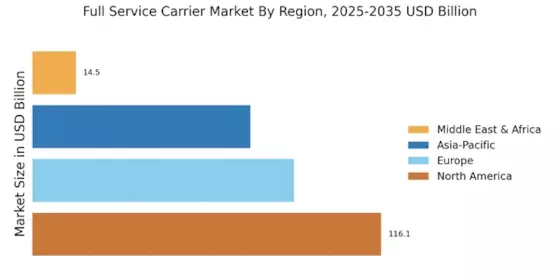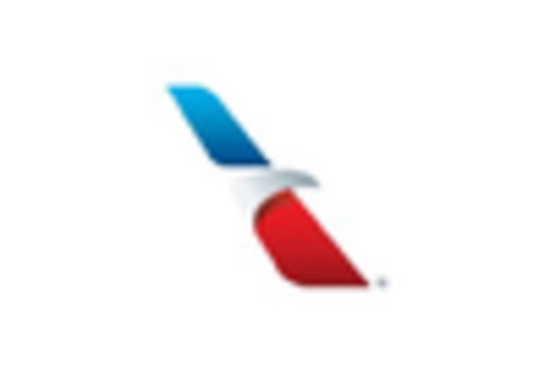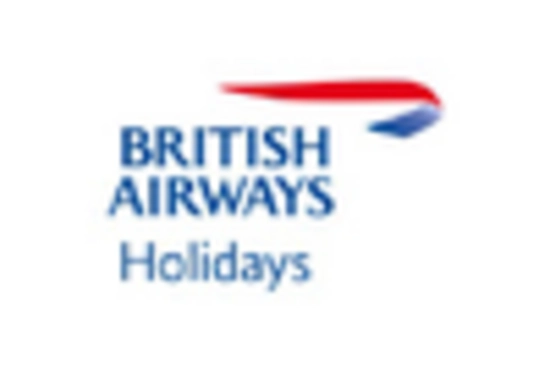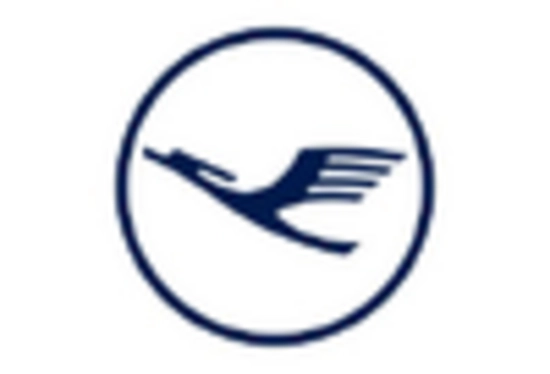Focus on Sustainability
The Full Service Carrier Market is increasingly prioritizing sustainability as a core component of their business strategies. Airlines are adopting eco-friendly practices, such as investing in fuel-efficient aircraft and exploring alternative fuels, to reduce their carbon footprint. Recent studies indicate that consumers are becoming more environmentally conscious, with a significant percentage willing to pay a premium for sustainable travel options. This shift in consumer behavior is prompting Full Service Carriers to enhance their sustainability initiatives, which may include carbon offset programs and waste reduction strategies. As regulatory pressures regarding emissions intensify, airlines that proactively embrace sustainability are likely to gain a competitive edge in the market. This focus on sustainability not only aligns with consumer expectations but also positions carriers favorably in an increasingly eco-aware industry landscape.
Technological Advancements
The Full Service Carrier Market is experiencing a notable transformation driven by technological advancements. Innovations such as artificial intelligence, machine learning, and data analytics are enhancing operational efficiency and customer service. Airlines are increasingly adopting these technologies to streamline processes, optimize flight schedules, and improve maintenance protocols. For instance, predictive maintenance powered by AI can reduce downtime and operational costs. Furthermore, the integration of mobile applications and digital platforms allows carriers to offer personalized services, thereby enhancing customer satisfaction. According to industry reports, airlines that leverage technology effectively can see a potential increase in revenue by up to 10%. This trend indicates that technological advancements are not merely supplementary but rather essential for competitiveness in the Full Service Carrier Market.
Rising Demand for Air Travel
The Full Service Carrier Market is witnessing a surge in demand for air travel, driven by increasing disposable incomes and a growing middle class in various regions. As more individuals can afford air travel, airlines are expanding their routes and services to cater to this burgeoning market. Recent data suggests that air passenger traffic is projected to grow at an annual rate of approximately 4.5% over the next decade. This growth is particularly evident in emerging markets, where the demand for both leisure and business travel is escalating. Consequently, Full Service Carriers are likely to enhance their offerings, including premium services and loyalty programs, to attract and retain customers. This rising demand not only fuels competition among carriers but also necessitates strategic planning and investment in fleet expansion and service enhancement.
Enhanced Customer Loyalty Programs
The Full Service Carrier Market is witnessing a transformation in customer loyalty programs, which are becoming more sophisticated and personalized. Airlines are recognizing the importance of retaining customers in a competitive landscape and are investing in loyalty initiatives that offer tailored rewards and experiences. Recent data suggests that effective loyalty programs can increase customer retention rates by up to 30%. Full Service Carriers are leveraging data analytics to understand customer preferences and behaviors, allowing them to create targeted offers that resonate with their clientele. Additionally, partnerships with hotels, car rental services, and other travel-related businesses are enhancing the value of loyalty programs. This strategic focus on customer loyalty not only fosters brand allegiance but also drives revenue growth, making it a crucial driver in the Full Service Carrier Market.
Regulatory Support and Infrastructure Development
The Full Service Carrier Market benefits from supportive regulatory frameworks and ongoing infrastructure development. Governments are increasingly recognizing the importance of aviation in economic growth and are investing in airport expansions and upgrades. Enhanced airport facilities and improved air traffic management systems facilitate smoother operations for airlines. For instance, recent initiatives in various countries aim to reduce congestion and improve safety standards, which directly impacts the efficiency of Full Service Carriers. Additionally, favorable regulations regarding international air travel are encouraging airlines to explore new markets. This supportive environment is likely to bolster the growth of the Full Service Carrier Market, as carriers can operate more efficiently and expand their networks with confidence.


















Leave a Comment